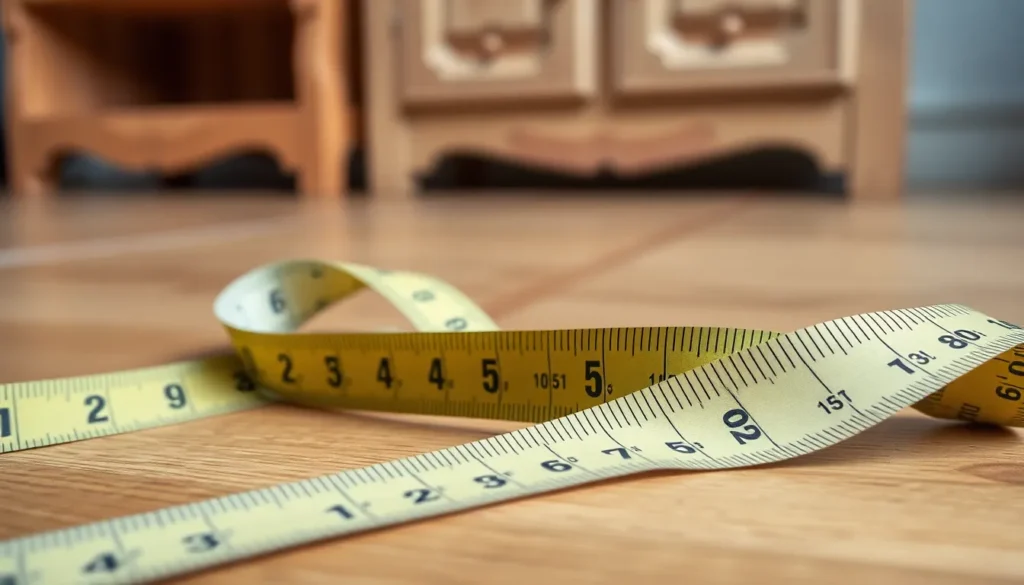When it comes to measurements, one inch might seem like a small deal, but it’s got a big impact. Whether you’re trying to figure out how much space you need for that new bookshelf or just settling a debate about the length of your friend’s fish story, understanding what one inch really means can save the day.
Think of it as the unsung hero of the measuring world—standing between a foot and a centimeter, it’s like the middle child of measurements: often overlooked but crucial in its own right. So, let’s dive into the fascinating world of inches and discover just how much one little inch can really matter in everyday life. Who knew a mere inch could pack such a punch?
Table of Contents
ToggleUnderstanding Inches
One inch serves as a fundamental unit of measurement in both the imperial and US customary systems. This measurement plays a crucial role in various applications, from construction to everyday activities.
Definition of an Inch
An inch equals 1/12 of a foot or 2.54 centimeters, establishing its position within multiple measurement systems. In practical terms, it helps individuals make accurate calculations when sizing objects or spaces. The symbol for inch is often represented as a double prime (″). Those needing precise measurements frequently rely on inches in contexts such as fabric lengths, furniture dimensions, and screen sizes. The simplicity of this unit lends itself well to everyday usage, making it easy to understand and apply for most people.
History of the Inch Measurement
The origin of the inch dates back to ancient civilizations. Various cultures defined it differently, such as the Romans, who based it on three barleycorns. England standardized the inch in the 14th century, later establishing the modern definition we use today. Legislation in 1959 defined the inch as exactly 2.54 centimeters, providing global consistency. Throughout history, the inch has evolved while remaining an integral measurement in daily life. Its versatility allows it to withstand the test of time, bridging gaps between traditional and contemporary uses.
Converting Inches to Other Units

Understanding conversions from inches to other units aids in accurate measurements across various applications.
Inches to Centimeters
One inch equals 2.54 centimeters. To convert inches to centimeters, multiply the inch measurement by 2.54. For example, 5 inches converts to 12.7 centimeters. Accuracy in conversion matters for tasks like tailoring or determining dimensions of objects. Additionally, understanding this conversion ensures clarity in international communications, as many countries utilize the metric system.
Inches to Millimeters
An inch translates to 25.4 millimeters. To convert inches to millimeters, simply multiply the inch value by 25.4. For instance, converting 3 inches results in 76.2 millimeters. This conversion proves essential in engineering and manufacturing contexts, where precise measurements dictate product quality. Utilizing the accurate conversions fosters effective collaboration in global projects.
Inches to Feet
One inch represents 1/12 of a foot. To convert inches to feet, divide the inch measurement by 12. For example, 24 inches equals 2 feet. In construction, accurate conversions from inches to feet ensures proper material allocations. Recognizing the relationship between these units streamlines project planning and execution, highlighting the inch’s role in everyday measurements.
Practical Uses of Inches
Inches play a significant role in everyday measurements, influencing countless daily activities and tasks.
Everyday Items Measured in Inches
Common items often measured in inches include smartphones, televisions, and furniture. Smartphone screen sizes frequently range from 5 to 6.5 inches, directly impacting user experience and portability. Televisions commonly range from 32 inches to 80 inches diagonally, with larger sizes gaining popularity for home theaters. Furniture dimensions are usually expressed in inches, guiding consumers in selecting the right pieces for their spaces. Light fixtures, cabinetry, and window treatments are also defined by inches, ensuring accurate fitting in homes and offices.
Importance in Various Fields
Inches hold particular importance in fields like tailoring, engineering, and construction. Tailors rely on precise measurements in inches to create well-fitting garments, while engineers utilize them for detailed specifications in design projects. Construction professionals measure materials in inches to ensure accuracy and minimize waste. These industries depend on the inch for effective communication and precision. Additionally, inches convert easily to other units, enhancing collaboration across different measurement systems.
Common Misconceptions About Inches
Misunderstanding inches occurs frequently, leading to confusion in everyday measurements. Many people think one inch is negligible in size, yet it significantly impacts countless applications.
Comparing Inches to Other Measurements
Inches relate closely to feet and centimeters, not just in use but also in conversion. One inch equals 1/12 of a foot, highlighting its position within the imperial system. In metric terms, one inch converts to 2.54 centimeters. This conversion clarifies dimensions across different systems. For example, when measuring a smartphone, its screen size often appears in inches but may also need conversion for clarity in international contexts. Inches play a crucial role in precision fields such as tailoring and engineering, as miscalculations can lead to serious errors.
The Impact of Metric System Adoption
Adopting the metric system has changed perceptions of inches in many regions. Many countries now prioritize metric units for scientific and everyday applications. This shift sometimes leads to the misconception that inches lack relevance or importance. Understanding inch conversions to centimeters and millimeters allows effective collaboration in international projects. For professionals in construction and engineering, knowing both systems ensures accuracy. Despite the growing use of metric measurements, inches remain essential in numerous industries, underscoring their ongoing significance.
One inch may seem trivial at first glance but its role in daily life is undeniable. This small unit of measurement influences everything from home decor to technology. Understanding its significance can enhance precision in various fields and improve communication across measurement systems.
As the inch continues to be relevant in an increasingly metric world, recognizing its value helps individuals make informed decisions in both personal and professional contexts. Whether measuring furniture or calculating fabric lengths, the inch remains a vital tool that deserves appreciation.





